US Treasuries — An investment to treasure for now and the future
I recently came across this super interesting stat...
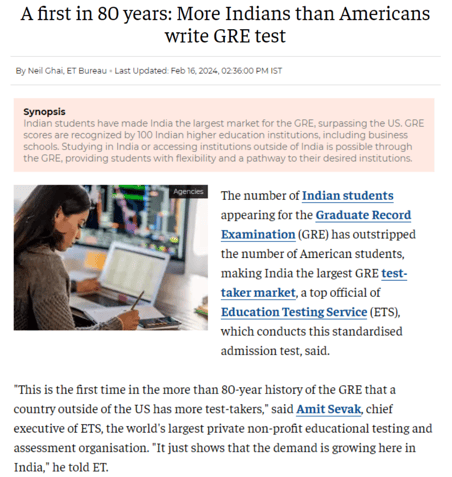
Source: Economic Times
In its 80-year history, this was the first time India overtook the US in the number of GRE test-takers (for the uninitiated, GRE is one of the most popular exams for college admission in US and other countries).
If this tells us anything, it’s that Indians are becoming more aspirational day by day. And as our aspirations get global, we need investment avenues that help us get there.
In our view, US Treasuries are a much-needed asset class for now and for the future.
Four reasons why you should invest in US Treasury bonds
1. US dollar exposure
We all know inflation is a key factor to consider when planning for our goals. But for goals outside of India, accounting for inflation is just one half of the equation.
You should also consider currency movement between the Indian rupee and the foreign currency. In this case, you should consider the exchange rates between USD and INR i.e. cost of US dollar in INR terms.
In the last ten years, US tuition costs grew at an annual rate of 3%.
But in the same period, the USD to INR exchange rate went up from 62 to 83 (annualised change of 3%). After factoring currency depreciation, the overall increase in tuition fees becomes 6% (annualised, in INR terms).
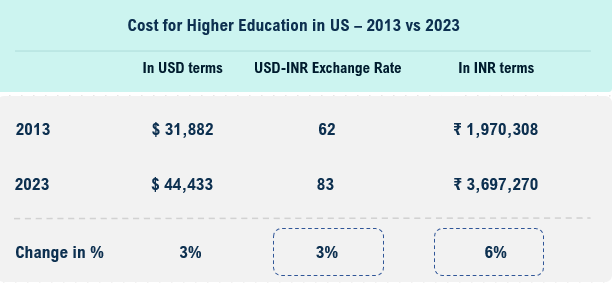
Source: US News & World Report, Bloomberg. Year-end exchange rates are considered. Above table is only for Illustration and does not guarantee returns.
Therefore, when planning for USD goals, you need an asset class that could help you account for both US Inflation as well as Rupee Depreciation and US treasuries provide just that!
2. Better capital protection as well as diversification
US Treasury bonds are essentially loans given to the US Government. They exhibit much lower volatility when compared to other asset classes such as US Equity – making them an ideal investment option.
The strength of US Treasuries as a diversifier is especially evident in times of crises. During periods of distress, money takes flight to safety. This results in increased demand for USD which often leads to strong outperformance of US Treasuries.
For instance, during the 2008 Global Financial Crisis, US 10 Year Bond outperformed India 10 Year Bond by 16%. And during the 2020 Covid Crash, the US 10 Year Bond outperformed by 17%.

Source: Bloomberg. Crisil, Internal. Past performance may or may not be sustained in future and should not be used as a basis for comparison with other investments. These figures pertain to performance of the index/model and do not in any manner indicate the returns/performance of this scheme.
3. Historical returns have been similar to Indian government bonds
Optically US Treasury bonds yields seem lower than the Indian G-Sec yields.
But after accounting for rupee depreciation, the long term returns of US government bonds have historically been similar to their Indian counterparts with intermittent periods of outperformance and underperformance.
Over 5 year rolling periods in the past 22+ years, US Treasury bonds delivered annualised returns of 7.3% on average (versus 7.2% for India G-Secs).
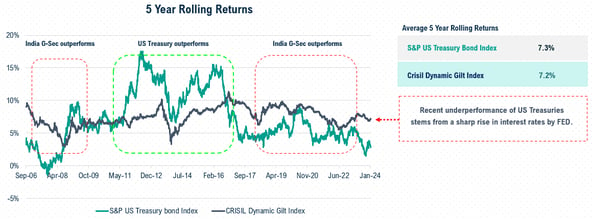
Source: Bloomberg. Data as on 31 Jan 2024. Past performance may or may not be sustained in future and should not be used as a basis for comparison with other investments. These figures pertain to performance of the index and do not in any manner indicate the returns/performance of this scheme.
4. A fall in US Yields could lead to additional gains
Between Mar-2022 and Jul-2023, the US Fed raised rates from 0.25% to 5.50% to curb inflation.
But the US inflation has been in a disinflationary trend for some time now and the wage growth has also started to soften in recent months. This indicates the possibility of rate cuts in the future. Further, the US government is also reducing its fiscal deficit which could bring down the supply of US Treasury securities. All these could result in lowering of US bond yields.
When yields fall, bond prices move up and this could result in extra returns.
For example, a bond portfolio with a modified duration of five years could make 5% in mark to market gains when yields fall by 1%.

Source: Internal
But what about the risks?
In the last nine years, US Fed Fund rates went through a cycle of hikes and cuts.
During periods of rate hikes, funds with lower duration such as Money Market and Floating Rate Bond portfolios had done well.
On the other hand, when rate cuts happened, Long Duration portfolios delivered better returns.
Medium Duration and Inflation-Linked bonds did well when rates were flat.
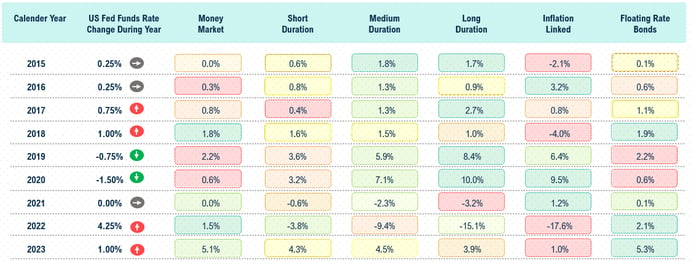
Source: Bloomberg, Internal. Returns in USD. The following indices / ETFs have been considered to represent different bond segments: Money Market - S&P U.S. Treasury Bill 0-3 Month Index Total Return, Short Duration - S&P U.S. Treasury Bond 1-3 Year Total Return Index, Medium Duration - Bloomberg Treasury 3-7 Year Total Return Index, Long Duration - S&P U.S. Treasury Bond 7-10 Year Total Return Index, Inflation Linked - iShares TIPS Bond ETF, Floating Rate Bonds - Bloomberg US Treasury Floating Rate Bond Index TR Index.
As seen above, the performance of different bond categories varies with the interest rate cycle.
However, this interest rate risk can be mitigated with an active management approach which takes duration calls dynamically depending on the rate cycle.
Suitability
US Treasury investments are a no-brainer for those who have USD expenses coming up.
Even if you do not have any US goals, US Treasuries can still form part of your portfolio given that the return profile (based on historical evidence) tends to be similar to Indian G-Secs and that they offer diversification benefits. Further, you can also take advantage of the current elevated yields which if normalised could result in additional returns.
So is there a way you can also try to benefit by investing in US treasury bonds? Yes, please talk to your MF Distributor or click below and we will get in touch.
About the author
Shrinath M L is Assistant Manager, Product at DSP Asset Managers. While Albert Einstein may or may not have said it, he still believes that compounding is the eighth wonder of the world.Disclaimer
In this material DSP Asset Managers Pvt. Ltd. (the AMC) has used information that is publicly available, including information developed in-house. Information gathered and used in this material is believed to be from reliable sources. While utmost care has been exercised while preparing this document, the AMC nor any person connected does not warrant the completeness or accuracy of the information and disclaims all liabilities, losses and damages arising out of the use of this information. The recipient(s) before acting on any information herein should make his/their own investigation and seek appropriate professional advice. The statements contained herein may include statements of future expectations and other forward looking statements that are based on prevailing market conditions / various other factors and involve known and unknown risks and uncertainties that could cause actual results, performance or events to differ materially from those expressed or implied in such statements. The sector(s)/stock(s)/issuer(s) mentioned in this presentation do not constitute any research report/recommendation of the same and the schemes of DSP mutual fund may or may not have any future position in these sector(s)/stock(s)/issuer(s). All opinions/ figures/ charts/ graphs are as on date of publishing (or as at mentioned date) and are subject to change without notice. Any logos used may be trademarks™ or registered® trademarks of their respective holders, our usage does not imply any affiliation with or endorsement by them. These figures pertain to performance of the index/Model and do not in any manner indicate the returns/performance of the Scheme. It is not possible to invest directly in an index.
Past performance may or may not be sustained in future and should not be used as a basis for comparison with other investments.
Mutual Fund investments are subject to market risks, read all scheme related documents carefully.

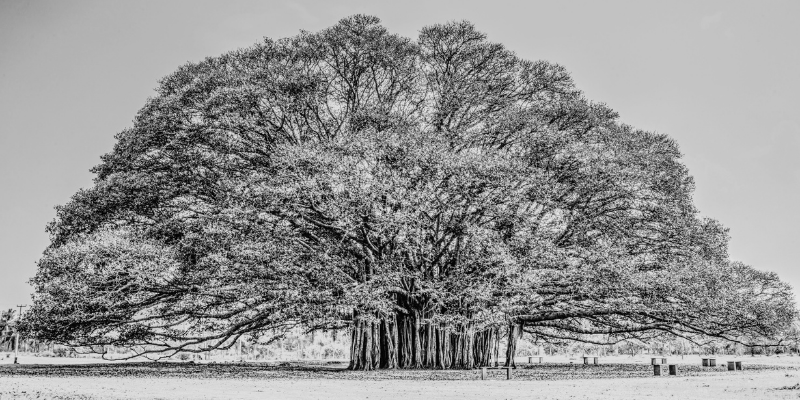





Leave a comment